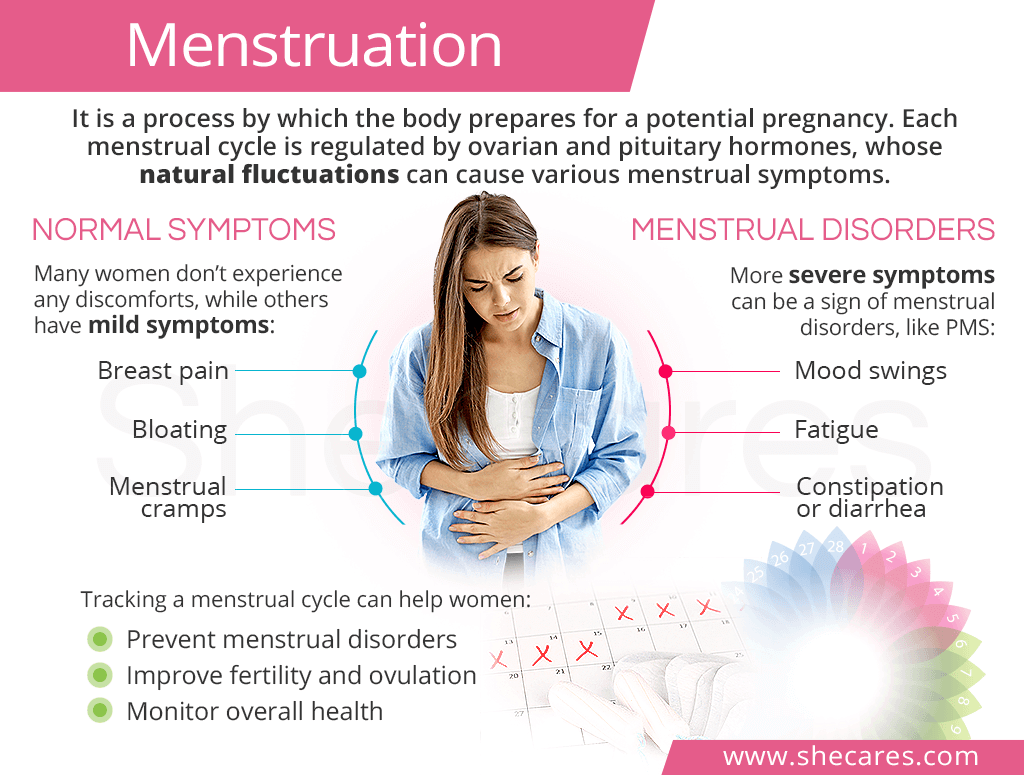Female Reproductive System
The female reproductive system is designed to make procreation possible. It contains both internal and external sex organs that enable the sperm to enter the female body through the vagina up to the uterus to fertilize an egg that has been timely released from the ovary and traveled through the fallopian tubes to the site of fertilization.
Besides egg production or its transport, the female reproductive system has a number of other important functions. They include the following:
Ovaries produce reproductive hormones, estrogen and progesterone, that drive the menstrual cycle.
Vagina not only receives the penis during sexual intercourse, but also protects the internal organs from infections and serves as a birth canal during delivery.
Uterus supports the growing fetus throughout pregnancy and contracts its muscles during childbirth, pushing the baby down the birth canal.
These functions are regulated by the hypothalamus, an area of the brain that stimulates the pituitary gland, adrenal glands, and sex organs to work together to release adequate hormones and sustain their appropriate roles.
Menstrual Cycle
Most females enter puberty between the ages of 10 and 15 when they experience menarche, the first menstrual bleeding. From then onwards, menstruation continues for about 40 years until menopause.
The purpose of menstruation is to prepare the body for a potential pregnancy. On a monthly basis, it starts with the release of an egg from the ovary and its journey through the fallopian tubes to the uterus for a possible fertilization. The cycle culminates in the egg's departure through the vagina if fertilization does not occur. This shedding of the egg and the uterine lining lasts for 3 to 7 days and is called menses or a period.
The entire menstrual cycle repeats roughly every 28 days and is divided into two phases:
Follicular phase, which lasts from the first day of menses until ovulation
Luteal phase, which lasts from ovulation until the first day of menses
The specific events throughout each of those phases are governed by four pituitary and ovarian hormones: follicle-stimulating hormones (FSH), luteinizing hormone (LH), estrogen, and progesterone.
Normal Period Symptoms
Natural fluctuations of reproductive hormones throughout the menstrual cycle can bring about a myriad of period symptoms. Many women do not experience many discomforts during their periods, whereas others might report mild physical symptoms right before and during menses. They might include:
- Breast pain or tenderness
- Bloating
- Muscles aches
- Menstrual cramps
- Lower back pain
It is important to make a distinction between typical symptoms women experience around the time of their periods from more severe physical and emotional symptoms characteristic to premenstrual syndrome (PMS) or premenstrual dysphoric disorder (PMMD), which are discussed below in the Menstrual Disorders section.
Menstrual Disorders
Almost 30% of women experience menstrual disorders during their reproductive years. These deviations from what is considered regular can relate to the length, frequency, or blood flow of a period as well as the intensity of menstrual symptoms.
Irregular Periods
Occasional irregular periods during various phases in a woman's life, such as puberty, pregnancy, or menopause, are normal and don't require intervention. However, irregularities that last longer than three months should be evaluated as they might have a more complex cause, like hormonal imbalance or thyroid disease.
Premenstrual Syndrome (PMS)
Another common menstrual disorder is PMS. It typically causes mild to moderate physical and emotional symptoms, such as mood swings, acne, fatigue, insomnia, or headaches, which start one or two weeks before a woman's period.
Premenstrual Dysphoric Disorder (PMDD)
When PMS symptoms become severe and include extreme psychological symptoms, like depression, irritability, anger, or apathy, they might signal a PMDD. Unlike PMS, this disorder is classified as a mental disorder that can interfere with women's daily activities and relationships.
Other Disorders
Certain medical conditions can also cause menstrual abnormalities. They include:
Polycystic ovary syndrome (PCOS), which is a hormonal disorder that can result in infrequent or missed periods among other symptoms, such as infertility, excessive hair growth, weight gain, or sleep disorders.
Endometriosis, which is a condition where the lining of the uterus grows outside of it, causing painful menstrual cramps, heavy or unusual bleeding patterns, or spotting between periods.
Menstrual Relief
When in need of immediate relief from mild symptoms, women have a wide variety of options at their disposal. They range from homemade remedies and natural supplements to over-the-counter or prescription medications.
Natural Remedies
Heat compresses on the pelvis with a heating pad or hot water bottle can acutely soothe the menstrual cramps.
Medicinal herbs, like cramp bark or oregano, can alleviate menstrual discomforts, such as painful periods or bloating.
Alternative therapies, like acupuncture or aromatherapy, have shown effective in relaxing the nervous system and reducing menstrual aches.
Medications
Over-the-counter pain relievers, such as naproxen or ibuprofen, can inhibit prostaglandins responsible for causing menstrual aches, thus relieving mild to moderate menstrual cramps.
Prescription medications, like diuretics or stronger nonsteroidal anti-inflammatory medications (NSAIDs), might be taken to relieve more severe symptoms of PMS and other menstrual disorders.
Most of the aforementioned strategies and PMS medications provide temporary relief from menstrual symptoms and do not treat the underlying cause. Wholesome practices aimed at reducing the risk factors for period problems are mentioned in the section below.
Healthy Periods
The best way to have healthy and regular periods is to reduce risk factors and resolve hormonal imbalance. There are a number of ways in which women can keep their health and hormones in check, thus decreasing the likelihood of menstrual disorders and unpleasant symptoms they trigger.
Implementing Healthy Lifestyle Habits
Although in many cases wholesome lifestyle practices do not cure the exact cause of menstrual abnormalities, they can work as supporting strategies to help women reach optimal health.
Ensure proper nutrition with a well-balanced diet and supplements, such as magnesium or calcium, to prevent nutritional deficiencies' effects on menstruation.
Maintain a normal weight with regular, non-strenuous exercises, like yoga or swimming, as obesity is one of the leading causes of menstrual abnormalities.
Control health conditions, like thyroid diseases or obesity, that might disrupt menstrual cycles.
Improve mental health, including reducing stress and curing depression, as they have all been linked to causing more severe menstrual problems due to elevated cortisol levels.
Treating Hormonal Imbalance
Resolving hormonal imbalances means treating period problems at their root. It can be achieved through natural or pharmacological treatments.
Herbal Supplements
Natural supplements are made with medicinal herbs and offer an effective solution to menstrual problems. They include:
Phytoestrogenic herbal supplements, like red clover, ginseng, and black cohosh, can relieve abnormal menstrual symptoms that are associated with low estrogen levels by bringing about hormonal balance.
Hormone-regulating supplements, such as Macafem, are the safest way to cure menstrual disorders, like irregular periods or PMS. They work by stimulating the endocrine glands to produce hormones more efficiently and bring them to equilibrium, thus relieving notorious menstrual symptoms.
Medications
Medications for hormonal regulation include:
Contraceptives, including birth control pills or intrauterine implants (UIDs), can help women of all ages regulate their menstruation. They can also be used to relieve the symptoms of PCOS or endometriosis.
Hormone replacement therapy (HRT) might be prescribed to women entering the menopausal transition whose periods have become irregular. In some cases, younger women might also benefit from hormonal therapy. However, due to serious side effects associated with the use of HRT, it is solely recommended to treat severe forms of hormonal imbalance.
Menstrual Hygiene
Menstrual hygiene is an important part of menstruation. Proper personal sanitation, comprising of frequent body washes and the use of menstrual products, is essential to disease prevention, such as the infections of the reproductive tract. It is also an important factor ensuring comfort, freshness, and confidence for women while on their periods.
Nowadays, there are tens of various menstrual products women can choose from to suit their needs and maintain proper hygiene, such as:
- Sanitary pads, including reusable pads
- Tampons
- Menstrual cups
- Sea sponges
- Period panties
When choosing menstrual products, it is essential to verify the ingredients on the package to ensure that they have not been made with harmful additives, such as bleaches or other toxic chemicals.
Period Trackers
Because a healthy, regular period is a good indication of women's overall health, tracking the rhythm of a menstrual cycle can help them stay on top of their well-being as well as prevent or prepare for pregnancy.
Period Trackers
There is a wide selection of period-tracking tools available on the market that can suit women's needs. They range from printable, color-coded calendars to interactive digital applications where a woman can chart in her period dates on a monthly basis.
Benefits of Tracking Periods
Besides enabling women to feel more in control over their bodies, period tracking can also benefit them in the following ways:
Monitoring overall health. It can help catch any irregularities, like hormonal imbalances, early on before they progress into more serious conditions.
Preparing for pregnancy. It can help women determine ovulation day and fertility window, which is the time when women are most likely to get pregnant.
Preventing pregnancy. Whether using natural methods or birth control options, knowing the rhythm of one's menstrual cycle is key to preventing unplanned conception or delaying it until later.
Conclusions
Menstruation is an integral part of being a woman. Although the monthly cycles are viewed as a bothersome malady by most females, the concept behind menstruation is quite extraordinary as it enables women to grow another human being inside their bodies if they choose to do so. Healthy lifestyle habits are essential for maintaining hormonal balance and preventing menstrual abnormalities. They might include eating a nutrient-rich diet, keeping a healthy weight with exercise, and taking natural supplements for healthy periods, like Macafem. Moreover, by learning all about periods and paying more attention to their rhythm, women can become more in tune with their physical and mental health.
Sources
- American College of Obstetricians and Gynecologists. (2015). Menstruation in Girls and Adolescents: Using the Menstrual Cycle as a Vital Sign. Retrieved July 3, 2018 from https://www.acog.org/Clinical-Guidance-and-Publications/Committee-Opinions/Committee-on-Adolescent-Health-Care/Menstruation-in-Girls-and-Adolescents-Using-the-Menstrual-Cycle-as-a-Vital-Sign
- CDC. (2017). Contraception. Retrieved July 3, 2018 from https://www.cdc.gov/reproductivehealth/contraception/index.htm
- Cleveland Clinic Journal of Medicine. (2010). Menstrual manipulation: Options for suppressing the cycle. Retrieved July 3, 2018 from https://www.ncbi.nlm.nih.gov/pubmed/20601618
- Health Direct. (n.d.). Female reproductive system. Retrieved July 3, 2018 from https://www.healthdirect.gov.au/female-reproductive-system
- Johns Hopkins University. (n.d.). Female Genital System. Retrieved July 3, 2018 from http://pathology.jhu.edu/shihlab/Teaching/Functional_Anatomy_of_Female_Genital_Tract.pdf
- Mayo Clinic. (2018). Birth control pill FAQ: Benefits, risks, and choices. Retrieved July 3, 2018 from https://www.mayoclinic.org/healthy-lifestyle/birth-control/in-depth/birth-control-pill/art-20045136
- Medline Plus. (2018). Menstruation. Retrieved July 3, 2018 from https://medlineplus.gov/menstruation.html
- National Institutes of Health. (2017). What causes menstrual irregularities? Retrieved July 3, 2018 from https://www.nichd.nih.gov/health/topics/menstruation/conditioninfo/causes
- Office on Women's Health. (2018). Period problems. Retrieved July 3, 2018 from https://www.womenshealth.gov/menstrual-cycle/period-problems
- PubMed. (n.d.). Menstruation (Periods). Retrieved July 3, 2018 from https://www.ncbi.nlm.nih.gov/pubmedhealth/PMHT0023146/


